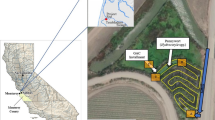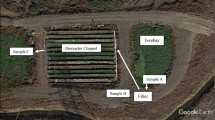Abstract
Use of neonicotinoid pesticides is increasing worldwide and there is growing evidence of surface water contamination from this class of insecticide. Due to their high solubility, traditional mitigation practices may be less effective at reducing neonicotinoid concentrations in agricultural runoff. In the current study, laboratory experiments were conducted to determine if granulated activated carbon (GAC) reduces concentrations of the neonicotinoid imidacloprid in water under simulated flow conditions. Imidacloprid was pumped through columns packed with GAC using flow rates scaled to mimic previously reported field studies. Treatments were tested at two different flow rates and samples were collected after 200 and 2500 mL of treated water were pumped through the column. Chemical analysis of the post-column effluent showed the GAC removed all detectable imidacloprid from solution at both flow rates and at both sample times. These results demonstrate the efficacy of GAC for treating neonicotinoids and the results are discussed in the context of incorporating this treatment into integrated vegetated treatment systems for mitigating pesticides in agricultural runoff. Future studies are being designed to evaluate this technology in full scale field trials.
Similar content being viewed by others
References
Anderson BS, Phillips BM, Hunt JW, Largay B, Shihadeh R, Berretti M, Tjeerdema RS (2011) Pesticide and toxicity reduction using an integrated vegetated treatment system. Environ Toxicol Chem 30:1036–1043
Bonmatin J-M, Giorio C, Girolami V et al (2015) Environmental fate and exposure: neonicotinoids and fipronil. Environ Sci Pollut Res 22:35–67
Cavallaro M, Morrissey CA, Headley JV, Peru KM, Liber K (2017) Comparative chronic toxicity of imidacloprid, clothianidin, and thiamethoxam to Chironomus dilutus and estimation of toxic equivalency factors. Environ Toxicol Chem 36(2):372–382
CDPR (2014) Department of pesticide regulation 2014 annual statewide pesticide use report indexed by chemical. http://www.cdpr.ca.gov/docs/pur/pur14rep/chmrpt14.pdf. Accessed 9 Nov 2016
CDPR (2016) Environmental fate of imidacloprid. http://www.cdpr.ca.gov/docs/emon/pubs/fatememo/Imidacloprid_2016.pdf. Accessed 9 Nov 2016
Deng X (2015) Surface water monitoring for pesticides in agricultural areas of California, 2014. California Department of Pesticide Regulation, Sacramento, p 1–4
Morrissey CA, Mineau P, Devries JH, Sanchez-Bayo F, Liess M, Cavallaro MC, Liber K (2015) Neonicotinoid contamination of global surface waters and associated risk to aquatic invertebrates: a review. Environ Int 74:291–303
Phillips BP, Anderson BS, Cahn M, Rego JL, Voorhees JP, Siegler K, Zhang X, Budd R, Goh KS, Tjeerdema RS (2017) An integrated vegetated ditch system reduces chlorpyrifos loading in agricultural runoff. Integr Environ Assess Manag 13(2):423–430
Simon-Delso N, Amaral-Rogers V, Belzunces LP et al (2015) Systemic insecticides (neonicotinoids and fipronil): trends, uses, mode of action and metabolites. Environ Sci Pollut Res 22:5–34
Stang C, Bakanov N, Schulz R (2016) Experiments in water-macrophyte systems to uncover the dynamics of pesticide mitigation processes in vegetated surface waters/streams. Environ Sci Pollut Res 23:673–682
Starner K, Goh KS (2012) Detections of the neonicotinoid insecticide imidacloprid in surface waters of three agricultural regions of California, USA, 2010–2011. Bull Environ Contam Toxicol 88:316–321
Stoughton SJ, Liber K, Culp J, Cessna A (2008) Acute and chronic toxicity of imidacloprid to the aquatic invertebrates Chironomus tentans and Hyalella azteca under constant- and pulse-exposure conditions. Arch Environ Contam Toxicol 54:622–673
US EPA (2016) Preliminary pollinator assessment to support the registration review of imidacloprid. http://www.regulations.gov/#!documentDetail;D=EPA-HQ-OPP-2008-0844-0140. Accessed 1 Dec 2016
Acknowledgements
Funding for the imidacloprid analysis was provided by Michael Ensminger, California Department of Pesticide Regulation. Imidacloprid analysis was conducted by the California Department of Fish and Wildlife Water Pollution Control Laboratory.
Author information
Authors and Affiliations
Corresponding author
Rights and permissions
About this article
Cite this article
Voorhees, J.P., Anderson, B.S., Phillips, B.M. et al. Carbon Treatment as a Method to Remove Imidacloprid from Agriculture Runoff. Bull Environ Contam Toxicol 99, 200–202 (2017). https://doi.org/10.1007/s00128-017-2074-x
Received:
Accepted:
Published:
Issue Date:
DOI: https://doi.org/10.1007/s00128-017-2074-x




